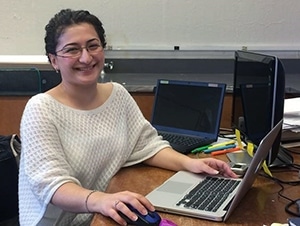Mar 16 2016
Researchers at the University of Cincinnati were excited when they realized that a new nanostructure, with higher properties for technological use, may allow doctors to observe and eliminate cancerous cells.
 Zohre Gorunmez, a fourth-year PhD student at the University of Cincinnati, conducting nearly three years of complex calculations to better understand a new SERS nanotag discovered by researchers at UC.
Zohre Gorunmez, a fourth-year PhD student at the University of Cincinnati, conducting nearly three years of complex calculations to better understand a new SERS nanotag discovered by researchers at UC.
The structure of SERS nanotag, as it has been referred to, is relatively new so the team led by Laura Sagle, an assistant professor of chemistry, with UC graduate students Debrina Jana, Jie He and Ian Bruzas, did not understand what generated the new data or the best way to optimize it.
Zohre Gorunmez, a fourth-year PhD student, performed about three years of detailed and complex calculations in order to understand the new nanotag in a better manner. She is scheduled to present her work at the American Physical Society’s March conference, being held from March 14 to 18 in Baltimore.
It was calculations that no one on campus had done before. Zohre, essentially by herself and without a lot of guidance and help, got these calculations up and running.
Laura Sagle, Assistant Professor of Chemistry, University of Cincinnati
The discovery was made in 2013 when the Sagle Lab research team was developing new methods to examine single molecules, utilizing a technique called surface-enhanced Raman spectroscopy (SERS).
SERS targets molecules by employing lasers, resulting in scattering of light at various wavelengths along a spectrum. Since the molecules generate weak signals, silver or gold nanoparticles are utilized for their amplification. The amplification is evaluated by a spectrometer for further analysis.
The process is sensitive and challenging, including difficulties with signal stability, reproducibility, and the absence of quantitative information.
Earlier research demonstrated greated enhancement from molecules present within a 1 nm gap between a structure with a smooth metallic core and shell. However this 1 nm gap, 100,000 times smaller than the width of a human hair, is usually difficult and costly to create, preventing widespread use.
The team discovered another research study, which used gold nanostars, a particle in the shape of a starfruit that allows for improved enhancement, but is acutely variable because of the difficulty in controlling the quantity and size of spiky tips.
The team combined the two concepts, and formed a structure that had a smooth inner metallic core, which was engulfed by a spiky metallic outer shell with a 3 nm spacing – a never-before-created technique.
The newly formed nanotag generated 10 times more signal enhancement, compared with smooth-shell core structures, enabling the detection of small quantity of organic molecules, including DNA.
Additionally the spiky structures generate heat more efficiently, which can be helpful for eliminating cancerous cells, and present a greater area to accomodate more drugs in order to deliver a highly targeted blast to the cancerous cells, said Sagle.
This allows you to target, image and release drugs all with one device.
Laura Sagle, Assistant Professor of Chemistry, University of Cincinnati
This discovery itself was new, but Sagle realized that the promising nanotag needs to be examined and modeled further for its use in biological applications.
Under the supervision of Thomas Beck, a professor of chemistry, Gorunmez learnt new code and programming to use in complicated data calculation. Her work was invaluable, said Sagle, which earned her the title of co-first-author of the paper describing the discovery.
With Zohre’s calculations, it was a much better paper showing we made something new, it showed better properties and we understand to some degree why.
Laura Sagle, Assistant Professor of Chemistry, University of Cincinnati
According to Gorunmez, the work was very challenging, but the prospect of the data’s use in biohealth applications is the driving factor.
It’s novel. I’m sure it’s going to help scientists in medical research to use those structures to get what they need. Knowing this gets me excited.
Zohre Gorunmez, Ph.D Student, University of Cincinnati